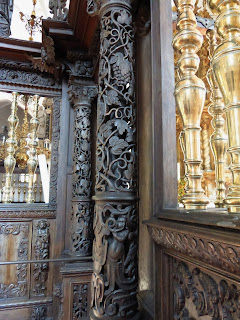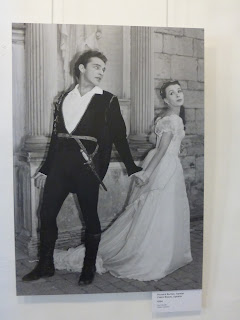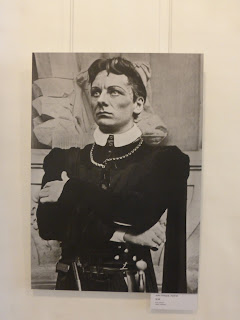I read James Serpell’s piece on familiar spirits,
‘Guardian Spirits or demonic Pets: The Concept of the Witch’s Familiar in Early
Modern England, 1530-1712, which appeared in Angela Creager and William
Jordan’s The Animal/Human Boundary:
Historical Perspectives (2002). It’s a thorough job, with some very good
quotations and a jolly chart of the various animal forms the devil was said to
have adopted.
The sources of bemusement remain: where such a
strange idea came from, and in particular why it was English witchcraft that so
featured the diabolic familiar in animal form.
It’s useful first to remind oneself of a widespread
psychological phenomenon:
The Wikipedia writers paraphrase from Klausen and Passman, ‘Pretend companions
(imaginary playmates): the emergence of a field’ in the Journal of Genetic Psychology (2006): “Adults in early historic
times had entities such as household gods and guardian angels, and muses that
functioned as imaginary companions to provide comfort, guidance and inspiration
for creative work.”
After a non-Christian origin, a conceptual and etymological
inevitability operated to produce the familiar spirit in animal form.
In Roman times, Ronald Hutton explains, you had a lares familiares, a guardian angel
called your genius (a woman might
have referred to hers as her natalis Juno). On your birthday, you made special
vows and little sacrifices to your genius
or juno on the household shrine, the lararium. Emperors, meanwhile, had a numen, and their re-union with their numen at death was what made a dead
emperor into a god. Evil spirits, says Lemprière, were the Larvae or Lemures. They
were considered to be the spirits of the dead, and ceremonies, Lemualia, were performed to keep them in
their graves or make them depart. These evil spirits are just a general
supernatural nuisance; they are not assigned to living individuals as opposites
to the genius.
The genius is
considered by some lexicographers to link to the word jinn. In Moslem tradition, Jorge Luis Borges explains, Allah
created three forms of intelligent beings: angels, from light, the jinn, from fire, and humankind, from
earth. The jinn can be evil. They
manifest, Borges reports his sources as saying, first of all as clouds or
undefined pillars, then can stabilise or condense into a human or animal form,
as jackal, wolf, lion, scorpion, or snake – definitely not as domestic animals.
Jinn can overhear angelic
conversations, and so pass on second hand vatic information to wizards. But the
harms attempted by an evil jinnee are
easily defeated by invoking the name of Allah, the all Merciful, the
Compassionate.
For the European tradition, the OED’s etymologies
take the story forwards. In post-classical Latin of the 12th
century, the guardian angel is the angelus
familiaris. Because the culture was Christian, and that culture was intensely
given, after Prudentius’ hugely popular 5th century Christian poem,
to analysing the psychomachia, the
battle happening in and around an individual soul, familiar devils followed,
c.1464. You now have both a Good and a Bad Angel, like Faustus, and they form a
morally effective pairing, as in this illustration:
A court scene, with the person testifying between
his evil and good angels.
From Ulrich Tengler, Der neü Leyenspiegel (Strassburg, 1514)
https://www.flickr.com/photos/yalelawlibrary/11734629074/in/album-72157639358477444/ (See folio CXXXV).
The OED assigns spiritus
familiaris to the 15th century, and has the term in its English form from
1545. EEBO can be used to add further quotations. The “familier spirit of a
mannes awne minde” is mentioned quite neutrally in the translation of Erasmus’
commentary of Cato’s precepts in 1553, while 1554 provides the more opprobrious
“one that had a familier spyrit, and used enchauntry” in a work by Richard
Smith.
Of course, the neutral use is in commentary on a
Roman writer. In the context of magic, the familiar spirit may have set off
like the daemon of Socrates, being the source of your knowledge. But when that
knowledge was forbidden, no neutral ‘daemon’ is possible: it is a demon
informing you (or, more likely, misinforming you).
Lurking in familiar
was a connection to the house: Latin, familiaris,
‘of a house, of a household, belonging to a family, household, domestic,
private’. Canis familiaris is the
domestic dog.
The Roman lares
familiaris or penates were
represented in the form of dancing human-shaped figures, who carry a libation
cup and dish. But when the familiar spirit is no longer a daemon but a demon, no longer a genius
but an evil genius, a witch-hunter
can infer that, as it would be instantly incriminating to have a largely
human-shaped devil visible in the household, the devil is going to be present either
invisibly, or disguised in animal form.
Genesis, as it had been interpreted from the second
century, gave ample warrant for Satan assuming animal form. Nobody could
imagine Jesus appearing to them in the form of a dog, but part of satanic
debasement was non-angelic form. Milton has his Satan suavely passing from
cormorant, to tiger, to toad, to serpent, as best serves his advantage.
Intelligent writers of Genesis-based poems, like Du Bartas and Milton, were
fascinated in just how Satan could get a snake to speak. Du Bartas even seems
to imagine that one way round this difficulty is that Satan, invisible, is
‘playing’ the serpent, like a brilliant musician coaxing a good sound from a
poor musical instrument (Sylvester, translating Du Bartas, interjects an
allusion to John Dowland’s ability to coax harmonious music out of a
broken-down old instrument).
 |
| Imputed 'devil's door', Warfield Church, Berkshire |
I think that the medieval church in general
down-played the genius or ‘good
angel’. They are mentioned, but really they occupied a role the church wanted
for itself: leaving aside special miraculous interventions by the Blessed
Virgin Mary, the church is the best protector. Having promoted itself to
guardian-angeldom, the church would naturally incline to emphasise what you
were being so well protected from. As an instance, on the Heritage Open Day
this last weekend, I cycled to Warfield Church in Berkshire, which has one of
the reputed ‘devil’s doors’. It is asserted that such small doors, in the North
wall of a church, were opened during the medieval Catholic baptismal rite –
involving exorcism – of a baby in the font placed near to the devil’s door.
Subsequently, ‘devil doors’ tended to be walled up: in the Reformation, it is
said. Maybe very early Christian buildings had a North-side door for the
not-yet baptised, and the feature was reproduced in later buildings. An exorcised
devil flying out of an aperture is such a common motif that such doors probably
did at some later time have that different function in a drama of exorcism
(absurd though it is for a spirit to require a doorway). This is a separate
issue; my point is about the church’s tendency to make the devil familiar. The
devil was inside you prior to your baptism, and he is always trying to resume
control, he will always be close at hand.
Once the devil had become multiplied into vast
numbers of evil spirits, every sinner can have one, and the church can busy
itself beating them away. Some irremissible sinners, demonology began to say,
struck personal covenants with devils. Invisible devils inevitably had a
neither-here-nor-there quality. It became the duty of the person accused of
witchcraft, or the person who said they were bewitched, to see devils. Particularly in England, and perhaps because the
English always seem to have accommodated an odd range of animals living with
them, animals already in the house were co-opted as devils; or in the absence
of animals, the assumed attendant devils were assigned animal forms by those
who claimed to be witnesses, or by witches who were trying to confess compliantly
enough to worm their way back into judicial favour.
The sinister, vice, element from psychomachia had in effect combined with
the household suggestions of ‘familiaris’
(“some domestical or familiar devil” in Daneau, A Dialogue of Witches, 1575) to suggest that the spirit prompting
to evil adopted disguise as a domestic animal, as when Elizabeth Stile
confessed that when she went to gaol, “her Bunne or Familier came to her in the
likenesse of a black Catte” (1579). The OED does not include this sense for the
noun ‘bun’, but it was in regular early modern use, alongside ‘imp’, as in Great News from the West of England: “In
the Town of Beckenton … liveth one William Spicer, a young Man about
eighteen Years of Age; as he was wont to pass by the Alms-house (where liveth an Old Woman, about Fourscore) he would
call her Witch, and tell her of her Buns; which did so enrage the Old Woman,
that she threatened him with a warrant…”
If the church had appropriated the role of good
genius, we can then see Milton’s Comus as
powerfully re-instating the guardian angel, the daemon, sent direct from heaven
to intervene - because Milton was well on the way to his repudiation of
organised worship.
I think the most revealing familiar spirits are
those whose forms and actions are recounted in Edward Fairfax’s Daemonologia. I say this because Helen
Fairfax, the writer’s eldest daughter, was simply making them up, deliberately
and in a calculated fashion, to get her father’s attention. Yes, reported
familiars were always made up, but in this case there’s no ambiguity about
delusions, or hysteria, or deception by a third party. Helen Fairfax simply let
rip, unleashed her imagination and expanding on themes she’d heard in other
reports.
She witnessed a Protean devil: human formed, then a
beast with many horns, then a calf, then “presently he was like a very little
dog, and desired her to open her mouth and let him come into her body, and then
he would rule the world”
Her father is completely credulous. On the 16th
November, 1621, a black dog, she said, had leapt onto her bed “and I tried if I
could feel the dog, but I felt nothing; and the wench said ‘The dog has leaped
down and gone’ ”
Then there is Margaret’s Wait’s alleged familiar “At
last the woman pulled out of a bag a living thing, the bigness of a cat, rough,
black, and with many feet”. This alarmingly non-tetrapodic beast keeps trying
to sit on the Bible Helen is conspicuously attempting to read.
More imaginative is the black cat: “when the cat
opened her mouth to blow on her, she showed her teeth like the teeth of a man
or woman”. This imaginary being mixes together the devil in animal form and the
witch who, in her animal form, is incompletely transformed.
The women that Helen Fairfax so heedlessly accused
were taken for examination. No supernumerary teats were found on them, and they
were acquitted when tried. The relentless Helen, who is making all this up,
subsequently sees a witch breast-feeding
her familiar, and is indignant at this crafty way of escaping exposure. She has
come up with a way the women at the York assizes escaped proper detection.
Finding her lies officially disbelieved only caused Helen to rally with more
lies.
What moved Helen Fairfax was said to be paternal
neglect. She maybe also took some pleasure in deceiving a father who had no
regard at all for her intelligence. A desire to be married and away from home
is also apparent. Satan appears to her as a gallant gentleman. The God himself
appears to her in the hall. This is too much for the family, who can believe in
the devil being present, but not God himself, and Helen swiftly adjusts her
story, as the God who appeared to her produces evasive answers, and finally
shows his horns.































